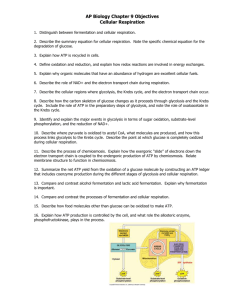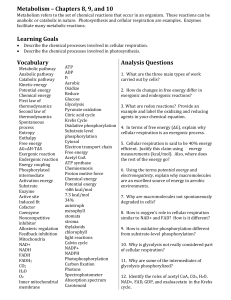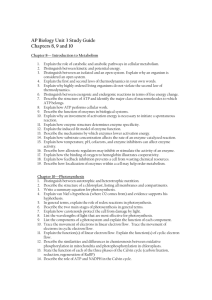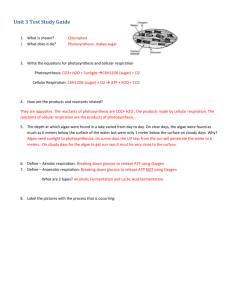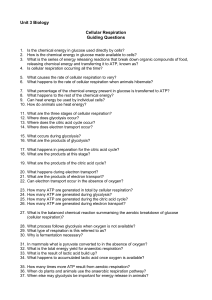Click Here For The Study Questions
advertisement
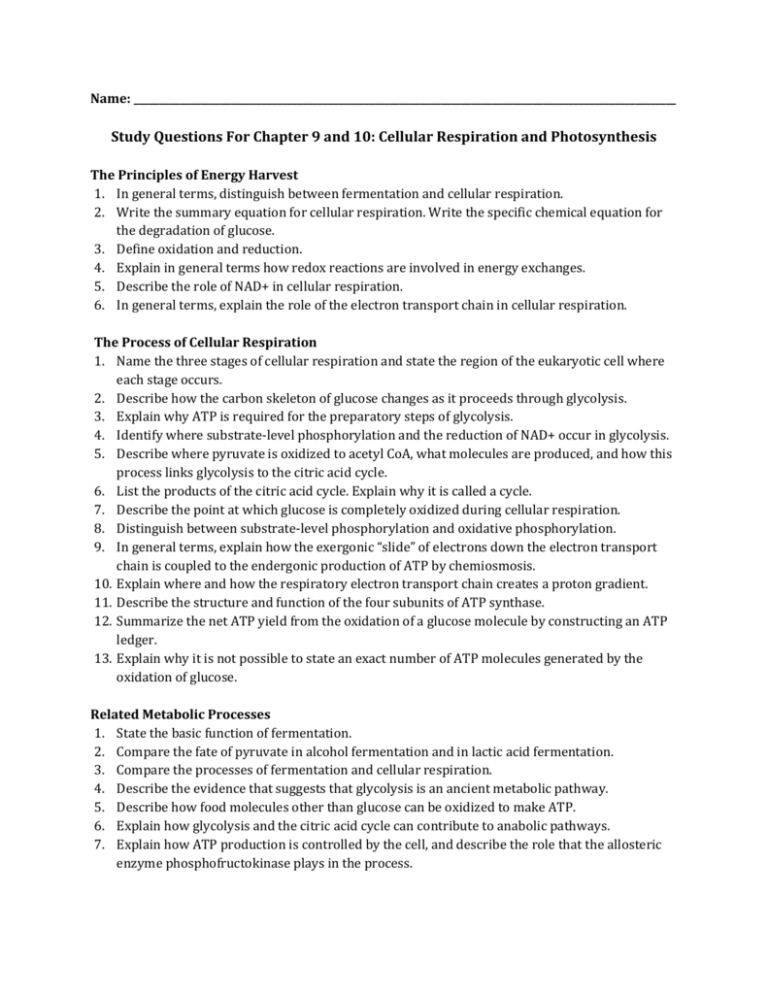
Name: __________________________________________________________________________________________________________ Study Questions For Chapter 9 and 10: Cellular Respiration and Photosynthesis The Principles of Energy Harvest 1. In general terms, distinguish between fermentation and cellular respiration. 2. Write the summary equation for cellular respiration. Write the specific chemical equation for the degradation of glucose. 3. Define oxidation and reduction. 4. Explain in general terms how redox reactions are involved in energy exchanges. 5. Describe the role of NAD+ in cellular respiration. 6. In general terms, explain the role of the electron transport chain in cellular respiration. The Process of Cellular Respiration 1. Name the three stages of cellular respiration and state the region of the eukaryotic cell where each stage occurs. 2. Describe how the carbon skeleton of glucose changes as it proceeds through glycolysis. 3. Explain why ATP is required for the preparatory steps of glycolysis. 4. Identify where substrate-level phosphorylation and the reduction of NAD+ occur in glycolysis. 5. Describe where pyruvate is oxidized to acetyl CoA, what molecules are produced, and how this process links glycolysis to the citric acid cycle. 6. List the products of the citric acid cycle. Explain why it is called a cycle. 7. Describe the point at which glucose is completely oxidized during cellular respiration. 8. Distinguish between substrate-level phosphorylation and oxidative phosphorylation. 9. In general terms, explain how the exergonic “slide” of electrons down the electron transport chain is coupled to the endergonic production of ATP by chemiosmosis. 10. Explain where and how the respiratory electron transport chain creates a proton gradient. 11. Describe the structure and function of the four subunits of ATP synthase. 12. Summarize the net ATP yield from the oxidation of a glucose molecule by constructing an ATP ledger. 13. Explain why it is not possible to state an exact number of ATP molecules generated by the oxidation of glucose. Related Metabolic Processes 1. State the basic function of fermentation. 2. Compare the fate of pyruvate in alcohol fermentation and in lactic acid fermentation. 3. Compare the processes of fermentation and cellular respiration. 4. Describe the evidence that suggests that glycolysis is an ancient metabolic pathway. 5. Describe how food molecules other than glucose can be oxidized to make ATP. 6. Explain how glycolysis and the citric acid cycle can contribute to anabolic pathways. 7. Explain how ATP production is controlled by the cell, and describe the role that the allosteric enzyme phosphofructokinase plays in the process. The Process That Feeds the Biosphere 1. Distinguish between autotrophic and heterotrophic nutrition. 2. Distinguish between photoautotrophs and chemoautotrophs. 3. Describe the structure of a chloroplast, listing all membranes and compartments. The Pathways of Photosynthesis 1. Write a summary equation for photosynthesis. 2. In general terms, explain the role of redox reactions in photosynthesis. 3. Describe the two main stages of photosynthesis in general terms. 4. Describe the relationship between an action spectrum and an absorption spectrum. Explain why the action spectrum for photosynthesis differs from the absorption spectrum for chlorophyll a. 5. Explain how carotenoids protect the cell from damage by light. 6. List the wavelengths of light that are most effective for photosynthesis. 7. Explain what happens when a solution of chlorophyll a absorbs photons. Explain what happens when chlorophyll a in an intact chloroplast absorbs photons. 8. List the components of a photosystem and explain the function of each component. 9. Trace the movement of electrons in noncyclic electron flow. Trace the movement of electrons in cyclic electron flow. 10. Explain the functions of cyclic and noncyclic electron flow. 11. Describe the similarities and differences in chemiosmosis between oxidative phosphorylation in mitochondria and photophosphorylation in chloroplasts. 12. State the function of each of the three phases of the Calvin cycle. 13. Describe the role of ATP and NADPH in the Calvin cycle. 14. Describe what happens to rubisco when O2 concentration is much higher than CO2 concentration. 15. Describe the major consequences of photorespiration. Explain why it is thought to be an evolutionary relict. 16. Describe two important photosynthetic adaptations that minimize photorespiration. 17. List the possible fates of photosynthetic products.

